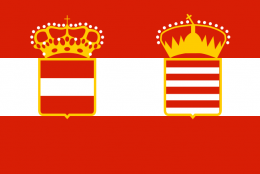Військово-морські сили Австро-Угорщини

The Austro-Hungarian Navy was the naval force of Austria-Hungary. Its name was commonly abbreviated in German as k.u.k. Kriegsmarine, and in Hungarian as Cs. és Kir. Haditengerészet. Ships of the k.u.k. Kriegsmarine were designated SMS, for Seiner Majestät Schiff (His Majesty's Ship). Existing between 1867 and 1918, the k.u.k. Kriegsmarine came into being after the formation of Austria-Hungary in 1867, and ceased to exist upon the Empire's defeat and subsequent collapse at the end of World War I.
Prior to the Austro-Hungarian Compromise of 1867, the Austrian Navy saw action in the French Revolutionary Wars, the Napoleonic Wars, the Second Egyptian–Ottoman War, the First and Second Wars of Italian Independence, the Second Schleswig War, and the Seven Weeks War as well as the simultaneous Third War of Italian Independence. Following Austria's defeat to Prussia and Italy during the Seven Weeks War, the Empire reformed itself into a dual monarchy with the Habsburg monarch ruling as Emperor of Austria over the western and northern half of the country that was the Austrian Empire, and as King of Hungary over the Kingdom of Hungary. The Austro-Hungarian Compromise of 1867 also transformed the Austrian Navy into the Austro-Hungarian Navy.
Largely neglected by the Empire in its early years, the k.u.k. Kriegsmarine grew throughout the late 19th and early 20th centuries to become one of the largest navies in the Adriatic and Mediterranean Seas. By 1914 the k.u.k. Kriegsmarine had a peacetime strength of 20,000 personnel. The k.u.k. Kriegsmarine saw action in the Boxer Rebellion, and the first shots of World War I were fired by the Austrian monitor Bodrog, which bombarded Belgrade on 29 July, 1914, the day after Austria-Hungary declared war on Serbia.
Participating in both surface and submarine warfare in the Adriatic and Mediterranean Seas during the war, the k.u.k. Kriegsmarine achieved notable victories during the Bombardment of Ancona and the Battle of the Straight of Otranto in 1917. However, the Otranto Barrage — established first by France and eventually maintained by Italy, the United Kingdom, and the United States — largely prevented the k.u.k. Kriegsmarine from participating in many naval engagements after 1915. Largely tasked with defending Austria-Hungary's 1,130 nautical miles (2,090 km; 1,300 mi) of coastline and 2,172.4 nautical miles (4,023.3 km; 2,500.0 mi) of island seaboard for the duration of the war, the k.u.k. Kriegsmarine chose to rely more on Austria-Hungary's U-boats to engage in offensive naval operations rather than risk the destruction of Austria-Hungary's battleships, cruisers, other surface vessels. In June 1918, the k.u.k. Kriegsmarine attempted to break the Otranto Barrage with a massive naval attack which included four dreadnought battleships three pre-dreadnoughts, the four cruisers, four destroyers, four torpedo boats, and numerous submarines and airplanes, but the attack was called off after the battleship Szent István was sunk by an Italian torpedo boat on 10 June.
Five months later, with the Austro-Hungarian Empire facing collapse and defeat in the war, the Empire decided to transfer most of its navy to the newly-declared State of Slovenes, Croats and Serbs on 31 October, effectively bringing the k.u.k. Kriegsmarine to an end. Three days later, the Empire's military authorities signed the Armistice of Villa Giusti, pulling the rapidly disintegrating empire out of the war. With the signing of the Treaty of Saint-Germain-en-Laye and the Treaty of Trianon, the First Austrian Republic and the Kingdom of Hungary were treated as the successors to the Austro-Hungarian Empire, whereas the independence of the West Slavs and South Slavs of the Empire as the First Czechoslovak Republic, the Second Polish Republic and the Kingdom of Yugoslavia, respectively, and most of the territorial demands of the Kingdom of Romania were also recognized by the victorious Allies in 1920. As a result, both Austria and Hungary were deprived of their coasts, and the former Empire's most important ports such as Trieste, Pola, Fiume, and Ragusa, were annexed into Italy and Yugoslavia. The k.u.k. Kriegsmarine's main ships meanwhile were turned over to the Allies where most of them were scrapped throughout the 1920s, though some of its ships remained in use through the 1930s and beyond, such as the Bodrog which remained in the service of multiple countries until the 1960s and is presently being converted into a museum ship.
- Коментарі
 uk
uk en
en ru
ru





